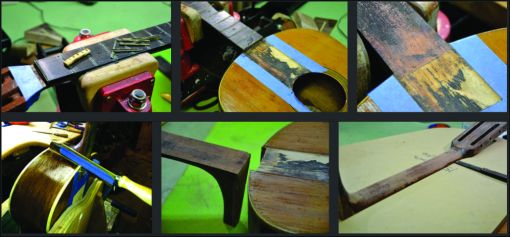Just completed a fun project for the owner of a little guitar built by Jacques Castelluccia in the late 1950s, early 60s. I suppose you could call this a parlor guitar or an OO size, the lower bout is about 14-1/2″ wide, 12 frets to the body. It has a classical guitar shape, but strung with steel, a flat top and a nicely molded arched back. It is ladder braced so has a very dry gypsy guitar sound. This guitar weighs less than three pounds and structurally was struggling with the pull of the strings. The unbraced arched back had straightened out some under string load and the neck had rotated up. The top had sunk under the bridge load and was actually below level by 3mm. The sting action at the 12th fret was 7mm, virtually unplayable. The bridge had been incorrectly located about 1-1/2″ (!!!) from where it should be for proper intonation. The dyed pear wood fingerboard was crumbling as they often do with time. Frets were pretty bad and the fret markers had long since vacated. The guitar had been badly refinished at some point.
As this was a unique guitar worthy of putting back into playing condition, but not an expensive guitar, it was decided to do what was needed to put it back into playing condition. A neck reset, new fingerboard, frets, nut saddle and a modest refinish. Doing something about the caving top was going to be fairly expensive, so as it appeared stable, this was left as is.
The first thing was to pull the frets and fingerboard which came up easily. Removing the neck was a bit of a struggle as the socket joint left no gaps into which to inject steam to loosen the glue. I drilled a series of small holes for this and after a morning’s worth of persuasion, the neck came loose in good shape. In cleaning up the neck shaft, I found it to be twisted about 1.5mm from one end to the other. This was fixed with a thin shim of wood on the top of the shaft and planed out.

Considering the generally light construction and the possibility of more neck rotation years from now, it was decided to convert the neck to a bolt on attachment which in this case was very easy to do and would make neck removal much easier next time. The neck socket head block was very thin and needed some beefing up, so 3/8″plate of spruce was added on the inside of the guitar and a thin plate of spruce at the bottom of the neck socket. The socket plate was adjusted to put the neck into proper alignment. The bolt on conversion was just a matter of threading on a couple inserts into the heel, bedded in epoxy and two holes through the heel block.

A new fingerboard was made from Indian Rosewood and slotted for a 640mm scale. The old fingerboard was flat in the classical style, the new one was given a 20″ radius like most better gypsy guitars. A tapered rosewood shim was made and installed to fill the gap between the fingerboard and guitar body with the new neck angle. New frets installed and the fingerboard reattached.
The whole guitar was given a modest sanding to smooth out the old rough finish. The old bridge footprint was blended in with stain. The bindings were scraped clean and brought back to a nice bright white. Several old, but deep grain pulls on the neck were filled and the whole business given four coats of lacquer. After setting up good, this was polished out and the guitar assembled. A new saddle and nut were made with the new bridge height setting a couple millimeters higher than the old one as desired.
The guitar now plays well with 2.8mm action and good intonation, and though not as powerful as larger gypsy guitars, it fits right in tone wise. For solos it has a great old school sound and as a rhythm guitar it is dry and crunchy. SWEET!



